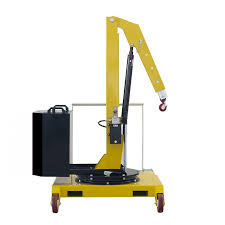Hydraulic Crane Lift Manufacturing
Hydraulic crane lifts are indispensable in a variety of industries, including construction, shipping, and logistics. These machines are engineered to handle heavy loads and facilitate efficient vertical lifting and lowering. The manufacture of hydraulic crane lifts involves a combination of mechanical engineering, hydraulic technology, and precision craftsmanship. This article delves into the key aspects of hydraulic crane lift manufacturing, exploring the design, components, production processes, and industry applications.
Design and Engineering
The design of a hydraulic crane lift is a complex process that requires expertise in mechanical engineering and hydraulics. Engineers begin by determining the specifications of the crane, including its lifting capacity, reach, and operational environment. These parameters guide the design of the crane's structure and hydraulic system.
-
Structural Design: The crane's structure, typically made from high-strength steel, must be robust enough to handle the maximum load capacity. Engineers use computer-aided design (CAD) software to create detailed blueprints and simulations of the crane. This stage involves optimizing the crane's geometry to balance strength and weight.
-
Hydraulic System Design: The hydraulic system is the heart of the crane lift. It consists of various components such as pumps, cylinders, valves, and hoses. Hydraulic engineers design the system to ensure smooth and reliable lifting operations. Key considerations include the hydraulic fluid's pressure and flow rate, which must be sufficient to achieve the desired lifting force.
Components of Hydraulic Crane Lifts
A hydraulic crane lift comprises several critical components, each contributing to its overall functionality:
-
Hydraulic Cylinders: These cylinders convert hydraulic pressure into mechanical force. They are typically made from high-strength materials and are designed to withstand significant pressure.
-
Hydraulic Pumps: Pumps are responsible for generating the hydraulic pressure needed for the crane’s operation. They come in various types, such as gear, vane, and piston pumps, each suited to different operational needs.
-
Valves: Hydraulic valves control the flow and direction of hydraulic fluid within the system. They regulate the lifting and lowering movements of the crane.
-
Hoses and Fittings: These components transport hydraulic fluid between different parts of the system. They must be durable and resistant to high pressures and environmental factors.
-
Boom: The boom is the crane's arm, which extends and retracts to reach different heights and distances. It is typically composed of multiple sections that can be articulated for greater flexibility.
-
Counterweights: To maintain stability during lifting operations, cranes are equipped with counterweights. These are carefully calculated and positioned to counterbalance the load being lifted.
Manufacturing Process
The manufacturing process of hydraulic crane lifts involves several stages, from raw material preparation to final assembly and testing:
-
Material Selection: High-quality materials, such as steel and hydraulic fluid, are selected based on their strength, durability, and resistance to wear and tear.
-
Fabrication: Raw materials are cut, shaped, and welded to create the crane's structural components. Precision machining is used to manufacture parts like hydraulic cylinders and pumps.
-
Assembly: The various components are assembled according to the design specifications. This stage involves installing the hydraulic system, mounting the boom, and integrating other essential parts.
-
Testing: Before a crane lift is delivered to the customer, it undergoes rigorous testing to ensure it meets safety and performance standards. This includes load testing, hydraulic pressure testing, and operational checks.
-
Quality Control: Throughout the manufacturing process, quality control measures are implemented to detect and correct any defects or inconsistencies. This ensures that the final product meets the required standards of safety and reliability.
Industry Applications
Hydraulic crane lifts are used in a wide range of applications, reflecting their versatility and efficiency:
-
Construction: In the construction industry, hydraulic cranes are used for lifting and placing heavy materials such as steel beams, concrete blocks, and machinery.
-
Shipping and Logistics: These cranes are essential for loading and unloading cargo from ships, trucks, and trains. Their ability to handle large and heavy loads makes them crucial in port operations.
-
Manufacturing: Hydraulic cranes are used in manufacturing facilities for moving heavy components, assembling machinery, and facilitating production processes.
-
Mining and Excavation: In the mining industry, hydraulic cranes assist in extracting and transporting minerals and other materials from excavation sites.
Future Trends
The manufacturing of hydraulic crane lifts is evolving with advancements in technology. Key trends include:
-
Automation: The integration of automation and control systems enhances the precision and efficiency of hydraulic cranes. Remote operation and telematics are becoming more common.
-
Materials Science: Innovations in materials science are leading to lighter and stronger crane components, improving overall performance and fuel efficiency.
-
Environmental Considerations: There is a growing emphasis on developing environmentally friendly hydraulic fluids and reducing the carbon footprint of manufacturing processes.
Conclusion
Hydraulic crane lifts are a vital component in various industries, facilitating the efficient handling of heavy loads. Their manufacture involves intricate design, advanced hydraulic technology, and precise engineering. As technology continues to advance, the industry is poised for innovations that will further enhance the capabilities and efficiency of hydraulic crane lifts, making them even more essential in the modern industrial landscape.
